التهاب الجيوب الأنفية هو حالة شائعة قد تتسبب عند البعض بآلام شديدة وصداع وذلك لأسباب فيروسية أو غيرها ويوجد عدة طرق حديثة لعلاجها في تركيا بالجراحة وغيرها.
تكون معظم حالات التهاب الجيوب الأنفية ناتجة عن فيروس وتختفي من تلقاء نفسها بعد فترة من الزمن، يعد التهاب الجيوب الأنفية الفيروسي معدياً، لذلك يجب على المصاب أن يتخذ الخطوات المناسبة لتجنب نقله للآخرين.
يتجاهل أغلب المرضى هذه الحالة باعتبارها غير هامة ولكن قد تتسبب عند البعض بآلام شديدة، وذلك بسبب التهاب يصيب الأغشية المبطنة للجيوب الأنفية في الجمجمة.
ما هي الجيوب الأنفية sinuses
الجيوب الأنفية هي تجاويف موجودة في القحف، موجودين بين العينان وخلف عظام الوجنتين وفي الجبهة، لهذه الجيوب فتحات توصلها بالأنف، تساعد هذه التجاويف في جعل الجمجمة أقل وزناً وتسمح بتدفئة الهواء الذي يدخل عبر الأنف، تكون الجيوب الأنفية مسؤولة أيضاً عن تحديد صوت الشخص الذي يتغير مع اهتزازات الهواء داخل الجيوب الأنفية.
بطانة هذه الجيوب لها نفس تركيب بطانة الأنف، تنتج جيوب الأنف إفرازاً لزجاً يسمى المخاط، يحافظ هذا المخاط على رطوبة ممرات الأنف، وهذا ما يساعد في الحماية من الغبار والمواد المسببة للحساسية والملوثات.
تشمل الجيوب الموجودة في الجمجمة ما يلي:
الجيبان الجبهيان
يتوضعان في العظم الجبهي ويوجد جيب في كل جانب خلف كل قوس حاجبية، ونادرا ما يكون الجيبان متناظرين، إذ أن الحاجز الفاصل بين الجيبين الجبهيين دائماً ما يميل باتجاه أحدهما، ينفتح الجيب الجبهي عبر القناة الجبهية الأنفية إلى القمع الغربالي والذي ينفتح بدوره ضمن الفرجة الهلالية في الصماخ الأوسط للأنف.
الجيب الوتدي
هو الجيب المفرد الوحيد في الرأس، يقع ضمن جسم العظم الوتدي وهو عميق قليلاً في الجمجمة، ويقع بالقرب من العصب البصري والغدة النخامية في الدماغ، ينفتح الجيب الوتدي على الردب الوتدي الغربالي عبر فتحة في الجدار الأمامي للجيب، حجمه متبدل إذ يمكن أن يمتد إلى داخل جذر الناتئ الجناحي والجناح الكبير للعظم الوتدي وكذلك القسم القاعدي للعظم القذالي.
الجيوب الغربالية
يتكون من مجموعة من الأجواف الصغيرة تدعى الخلايا الغربالية والتي تقع ضمن التيه الغربالي، يتم تقسيم خلايا الجيوب الغربالي حسب موقعها إلى ثلاثة أقسام:
- الخلايا الغربالية الأمامية وهي تشكل القسم الأمامي من أجواف الجيب الغربالي والمحتفرة ضمن التيه الغربالي، تفتح الخلايا الغربالية الأمامية على القمع الغربالي والذي يفتح بدوره على القسم الأمامي من الفرجة الهلالية وهي عبارة عن ثلم هلالي الشكل في الجدار الوحشي للصماخ الأوسط للأنف.
- الخلايا الغربالية الوسطى وهي عبارة عن مجموعة من الأجواف تشكل القسم المتوسط من الجيب الغربالي، تبرز الخلايا الغربالية المتوسطة ضمن جوف الأنف لتشكل بروز في الجدار الوحشي للصماخ الأنفي الأوسط يدعى الفقاعة الغربالية، تفتح الخلايا الغربالية الوسطى على الفقاعة أو بالقرب منها.
- الخلايا الغربالية الخلفية وهي مجموعة من الأجواف الصغيرة، تفتح هذه الأجواف على جوف الأنف عن طريق الصماخ الأنفي العلوي.

الجيبان الفكيان
كبيران ويقعان خلف عظام الوجنتين على جانبي الأنف، وهي على شكل هرم وتعتبر أكبر الجيوب الأنفية في الرأس.
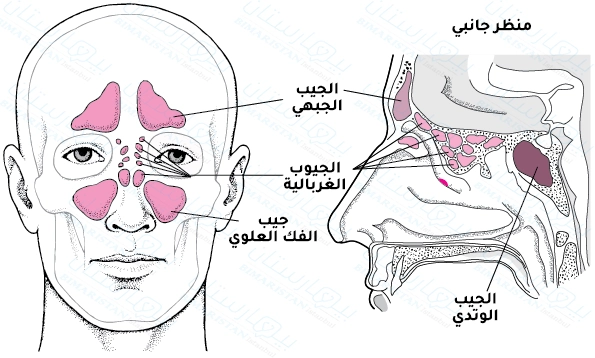
ما هو التهاب الجيوب الأنفية sinusitis
التهاب الجيوب الأنفية هو التهاب أو تورم في الغشاء المبطن للجيوب الأنفية.
تمتلئ الجيوب الأنفية السليمة بالهواء، ولكن عندما تنسد وتمتلئ بالمخاط يمكن للجراثيم أن تنمو وتسبب العدوى.
تشمل أسباب التهاب الجيوب الأنفية الفيروسات والبكتيريا والفطريات والحساسية ورد فعل المناعة الذاتية.
على الرغم من أن التهابات الجيوب الأنفية مؤلمة ومزعجة، إلا أنها غالباً ما تختفي دون تدخل طبي ومع ذلك، إذا كانت الأعراض شديدة ومستمرة، يجب على المريض استشارة الطبيب.
أعراض التهاب الجيوب الأنفية
تختلف أعراض التهاب الجيوب الأنفية اعتماداً على مدة استمرار الحالة وشدتها ويلاحظ عموماً عند مرضى التهاب الجيوب الأنفية:
- إفرازات أنفية قد تكون صفراء أو خضراء.
- تنقيط أنفي خلفي، حيث يتدفق المخاط إلى أسفل الحلق.
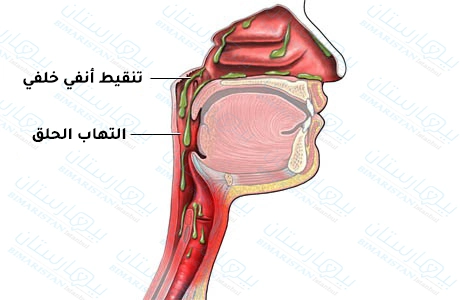
أسباب الإصابة بالتهاب الجيوب الأنفية
يمكن أن ينشأ التهاب الجيوب الانفية عن عدة عوامل، ولكنه يتضمن دائماً احتباس السوائل في الجيوب الأنفية، مما يسمح بنمو الجراثيم وتكاثرها فيها.
السبب الأكثر شيوعاً هو الفيروسات، يمكن للعدوى البكتيرية أيضاً أن تؤدي إلى التهاب الجيوب الأنفية، هناك بعض العوامل المهيجة لالتهاب الجيوب الأنفية مثل الحساسية والربو، وكذلك الملوثات الموجودة في الهواء، مثل المواد الكيميائية.
يمكن للعدوى الفطرية أن تكون سبب التهاب الجيوب الأنفية الفطري fungal sinusitis.
العوامل التي تزيد من خطر الإصابة بالتهاب الجيوب الانفية
- وجود عدوى سابقة في الجهاز التنفسي، مثل الزكام.
- السلائل الأنفية، وهي عبارة عن أورام حميدة صغيرة في الممر الأنفي يمكن أن تؤدي إلى الانسداد والالتهاب.
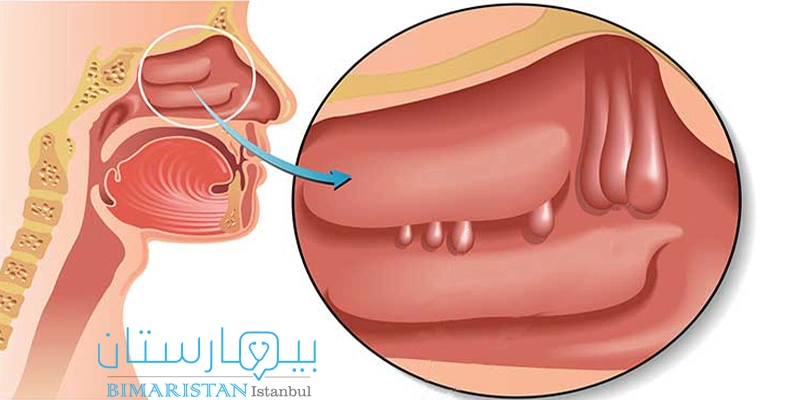
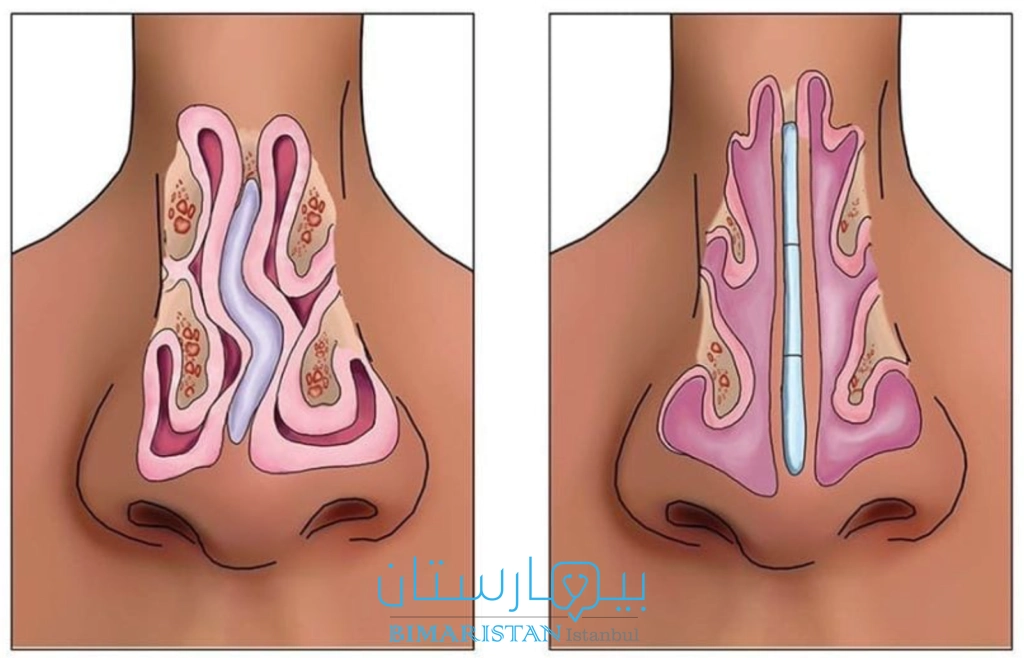
أنواع التهاب الجيوب الأنفية
هناك نوعين لالتهاب الجيوب الأنفية، يختلفان عن بعضهما عموماً بالفترة الزمنية التي تستمر فيها الحالة المرضية ويعتمد وقت الشفاء والعلاج على نوع الالتهاب، وهما:
التهاب الجيوب الأنفية الحاد Acute sinusitis
التهاب مؤقت ويمكن أن يحدث عندما يعاني الشخص من نزلة برد أو حساسية موسمية، تزول الأعراض عادة في غضون 7-10 أيام ولكن يمكن أن تستمر حتى 4 أسابيع.
قد يكون من الصعب التنفس من خلال الأنف عند الإصابة بالتهاب الجيوب الأنفية الحاد، قد يشعر المريض بتورم في المنطقة حول العينين، وقد يشعر بألم نابض بالوجه أو صداع.
التهاب الجيوب الأنفية المزمن Chronic sinusitis
يدعى أيضاً بـ chronic rhinosinusitis يحدث التهاب الجيوب الأنفية المزمن عندما تستمر الأعراض لأكثر من 12 أسبوعاً أو تعود لتظهر ثلاث مرات خلال عام واحد.
أظهرت الدراسات أن أكثر من 50٪ من المصابين بالربو المتوسط إلى الحاد يعانون أيضاً من التهاب الجيوب الأنفية المزمن.
متى يجب زيارة الطبيب؟
عادةً ما تكون العلاجات المنزلية كافية للتعافي ومع ذلك، يجب على المريض مراجعة الطبيب إذا كانت الأعراض:
- تدوم أكثر من 10 أيام دون أن تتحسن.
- تتضمن أعراض شديدة لا تختفي مع الأدوية التي لا تستلزم وصفة طبية.
- تشمل تغيرات في الرؤية أو تورم حول العينين.
- تتفاقم بعد فترة من التحسن.
- تشمل الحمى التي تستمر لأكثر من 3-4 أيام أو تزيد عن 101.5 درجة فهرنهايت (38.6 درجة مئوية).
قد تكون هناك أعراض أخرى، إذا كانت الأعراض مقلقة، فاطلب المساعدة الطبية مباشرة.
تشخيص التهاب الجيوب الأنفية
يمكن للطبيب إجراء التشخيص من خلال:
- السؤال عن الأعراض.
- إجراء الفحص البدني.
- استخدام المنظار لفحص ممرات الأنف والجيوب الأنفية.
- إجراء التصوير بالرنين المغناطيسي أو التصوير المقطعي المحوسب للتحقق من وجود مشاكل بنيوية.
- إجراء اختبارات الحساسية لتحديد المحفزات المحتملة.
العلاجات المنزلية لالتهاب الجيوب الأنفية
في حوالي 70٪ من الحالات يُشفى التهاب الجيوب الأنفية الحاد بدون وصفة طبية.
العلاجات المنزلية المختلفة والأدوية التي تصرف بدون وصفة طبية يمكن أن تخفف الأعراض.
من أمثلة هذه العلاجات والأدوية ما يلي:
- الإرواء الأنفي ويتم من خلالها غسل تجويف الأنف لطرد المخاط الزائد من الأنف والجيوب الأنفية، غسل الأنف بمعنى أوسع يشير أيضاً إلى استخدام رذاذ الأنف الملحي أو البخاخ لترطيب الأغشية المخاطية، وعاء نيتي هو أحد طرق القيام بذلك، وهو إناء مصمم لشطف وتنظيف تجويف الأنف من الفضلات أو المخاط، قد يستخدم وعاء نيتي لعلاج حساسية الأنف أو مشاكل الأنف أو نزلات البرد.
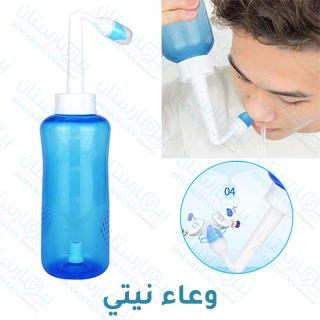
عادةً لا تعد مضادات الهيستامين، مثل السيتريزين (زيرتيك) ولوراتادين (كلاريتين) خيارات مناسبة، حيث يمكن أن تتسبب في تصلب المخاط، مما يجعل الأعراض أسوأ.
يمكن للطبيب أو الصيدلي تقديم المشورة بشأن هذه الخيارات وكيفية استخدامها.
علاج التهاب الجيوب الأنفية في تركيا
تعتمد خيارات العلاج على نوع الالتهاب والذي يعتمد أساساً على مدة استمرار الحالة.
التهاب الجيوب الأنفية الحاد وتحت الحاد Acute and subacute sinusitis
عادةً، لا تحتاج إلى أي إجراء، ولكن إذا استمرت الأعراض أو كانت شديدة، فيمكن عندها للطبيب أن يصف العلاج.
في حال وجود عدوى بكتيرية، قد يصف الطبيب الصادات الحيوية، ولكن إذا استمرت الأعراض بعد الانتهاء من الجرعة المحددة، يجب على المريض العودة إلى الطبيب.
طرق الوقاية من التهاب الجيوب الأنفية المزمن Chronic sinusitis
لا يحدث التهاب الجيوب الأنفية المزمن عادةً بسبب البكتيريا، لذلك من غير المرجح أن تساعد المضادات الحيوية.
قد يؤدي تقليل التعرض للمحرضات، مثل الغبار وحب الطلع والمواد الأخرى المسببة للحساسية، إلى تخفيف الأعراض.
قد تساعد بخاخات أو أقراص الكورتيكوستيروئيد في السيطرة على الالتهاب، ولكنها غالباً ما تحتاج إلى وصفة طبية وإشراف طبي، ويمكن أن يؤدي استخدام هذه الأدوية على المدى الطويل إلى آثار ضارة.
علاج التهاب الجيوب الأنفية بالجراحة في تركيا
قد يوصي الطبيب بإجراء عملية جراحية إذا لم تنجح العلاجات الأخرى، يعد هذا خياراً للأشخاص الذين يعانون من التهابات الجيوب الأنفية المزمن، أو للأشخاص الذين يعانون من بنية غير طبيعية للجيوب الأنفية، أو نمو غير طبيعي في الجيوب الأنفية.
ومع ذلك قد لا تحل الجراحة المشكلة تماماً، وغالباً ما يحتاج المريض إلى مواصلة العلاجات الأخرى بعد الجراحة لمنع عودة التهاب الجيوب الأنفية مرة أخرى.
إن جراحة الجيوب الأنفية هي إجراء يهدف إلى فتح ممرات الجيوب الأنفية وإزالة كل ما يعيق مسارات التصريف فيها، ويشمل ذلك إزالة:
- قطع رقيقة من العظام.
- الأغشية المخاطية.
- الزوائد الأنفية.
- أنسجة منتفخة أو تالفة.
- الأورام التي تسد ممر الأنف أو الجيوب الأنفية.
النوع الأكثر شيوعاً من جراحات الجيوب الأنفية هو الجراحة بالمنظار ومع ذلك، هناك إجراءات أخرى يمكن تنفيذها:
جراحة التنظير الوظيفي للجيوب الأنفية FESS
يتم إجراء FESS باستخدام أداة تسمى المنظار الداخلي وهو أنبوب رفيع، يتم إدخال المنظار في الأنف للوصول إلى فتحات الجيوب الأنفية، يمكن بعد ذلك تمرير التلسكوبات الدقيقة والأدوات الجراحية واستخدامها لتنفيذ الإجراء، يستخدم الجراح هذه الأدوات لإزالة العوائق التي تسد الممرات الأنفية.
يتم إجراء العملية بالكامل من خلال فتحتي الأنف ولا تترك أي ندوب، قد يحدث بعض التورم، لكنه يختفي بسرعة كبيرة، عادةً ما يشعر المريض الذي خضع لهذه الجراحة بعدم الراحة إلى فترة قصيرة من الزمن.
يمكن إجراء FESS بشكل متكرر أكثر من مرة، ويمكن أيضاً إجراؤها في العيادات الخارجية.
لتفاصيل أكثر يمكنكم مراجعة المقال.
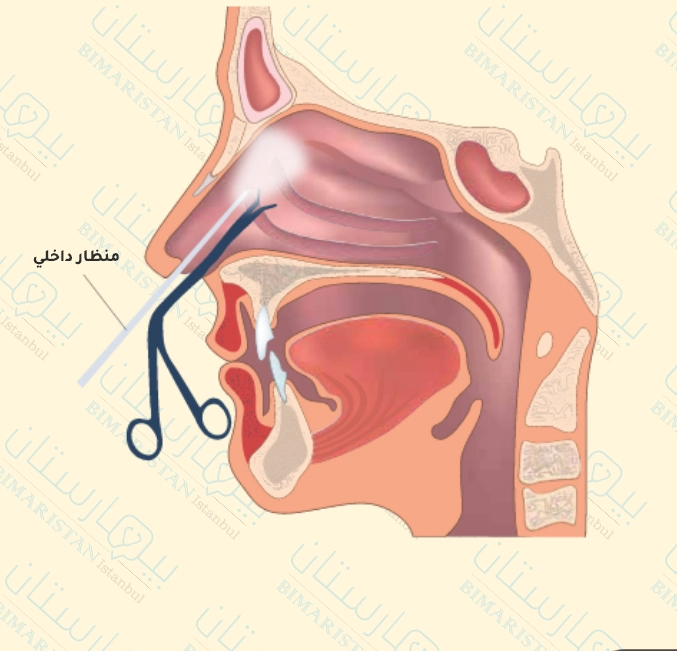
الجراحة الموجهة بالصور IGS
جراحة المناظير الموجهة بالصور هي إجراء جديد قد يوصى به للأشكال الشديدة من انسداد الجيوب الأنفية.
وتُستخدم الأشعة المقطعية CT والأشعة تحت الحمراء لمساعدة الجراح في تحديد البنى التشريحية و استئصال أقل قدر ممكن من الانسجة الأنفية، باستخدام هذا التوجيه، يمكن للجراح التنقل في ممرات الجيوب الأنفية وإزالة الأنسجة والعوائق الأخرى بدقة.
عملية كالدويل-لوك Caldwell-Luc
هذا الإجراء أقل شيوعاً وأكثر عدوانية، يُلجأ إلى القيام به عندما يكون هناك نمو غير طبيعي ضمن الجيب، ويهدف إلى إيجاد طريق لتفريغ مفرزات الجيب للخارج.
يقوم الجراح بعمل شق في الفك العلوي، فوق الضرس الثاني، ثم يدخل في تجويف الجيب من خلال هذا الشق، ويتم إجراء هذه الجراحة تحت تأثير التخدير الموضعي أو العام.
عند الأطفال، يجب أن تكون الجراحة هي الملاذ الأخير للعلاج، وحتى إذا أوصى الطبيب بإجراء عملية جراحية لعلاج التهاب الجيوب الأنفية عند الطفل، فقد يكون من الأفضل الحصول على رأي ثانٍ قبل المضي قدماً بذلك الخيار.
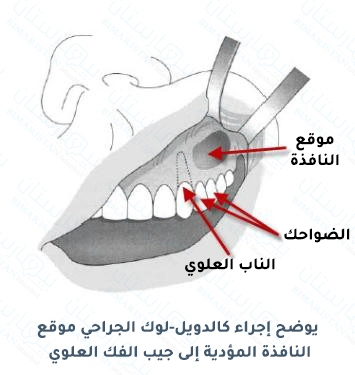
التعافي بعد الجراحة
اعتماداً على نوع الجراحة والحالة الصحية، يمكن المريض العودة للمنزل في اليوم ذاته أو في اليوم التالي للجراحة.
غالباً ما يشعر المريض بعد العملية بعدم الراحة إضافة إلى تقشر واحتقان ونزف بسيط من الأنف، لكنها أعراض اعتيادية ولا تستدعي القلق وسرعان ما تزول مع الالتزام بالأدوية الموصوفة من قبل الأخصائي المسؤول عن الحالة.
غالباً ما تشتمل الأدوية الموصوفة للمريض خلال الفترة الأولى بعد الجراحة على بعض المضادات الحيوية وبخاخات للأنف.
يوضع داخل الأنف في موضع قريب من الجيوب الأنفية القليل من الشاش أو الضمادات وذلك للسيطرة على النزيف، يمكن أن تكون قابلة للامتصاص فتذوب بمرور الوقت، وإذا كانت غير قابلة للامتصاص، فسيتعين على الطبيب إزالتها.
قد تنقضي أيام قبل أن يبدأ المريض بالشعور بالتحسن ويعتمد ذلك على حالته الصحية وعمره، وللوصول لنتائج أفضل وتجنب المضاعفات والآثار الجانبية قدر المستطاع، يجب اتباع مجموعة من النصائح خلال الفترة التالية للعملية:
- تجنب نفث الإفرازات من الأنف (النفخ من الأنف للخارج).
- إبقاء الفم مفتوحاً قدر الإمكان عند العطاس، وذلك لتخفيف الضغط داخل الجيوب الأنفية.
- رفع الرأس أثناء النوم عبر وضع وسادة إضافية تحت الرأس.
يجب على المريض اتباع تعليمات الطبيب في الفترة اللاحقة للجراحة، وتناول جميع الأدوية على النحو الموصوف، قد يضطر المريض إلى إجراء تغييرات في روتينه اليومي في أول أسبوعين بعد الجراحة.
الوقاية من التهاب الجيوب الأنفية
قد تساعد النصائح التالية في الوقاية من التهاب الجيوب الأنفية:
- تجنب التدخين والتدخين السلبي.
- مواكبة اللقاحات الحديثة الموثوقة.
- الابتعاد عن الأشخاص المصابين بنزلات البرد والتهابات الجهاز التنفسي الأخرى.
- استخدام المرطبات لترطيب الهواء بالمنزل والحفاظ عليه منعشاً.
- صيانة المكيفات الهوائية وتنظيفها باستمرار لمنع تجمع العفن والغبار فيها.
- تجنب المواد المسببة للحساسية والتعامل معها قدر الإمكان.
الفرق بين الحساسية والتهاب الجيوب الأنفية
تحدث الحساسية عندما يبالغ جهاز المناعة في الجسم في رد فعله تجاه المهيجات ومسببات الحساسية، بينما تكون عادةً أسباب التهاب الجيوب الأنفية، جرثومية أو فيروسية.
يمكن أن تكون أعراض الحساسية والتهابات الجيوب الأنفية متشابهة جداً، يمكن أن تسبب كلتا الحالتين آلاماً في الجيوب الأنفية وضغطاً وسيلاناً واحتقاناً وعطساً، كما يمكن أن تؤدي الحساسية أحياناً إلى التهاب الجيوب الأنفية، ومع ذلك يمكن لبعض الفروق الدقيقة أن تساعد الشخص على معرفة ما إذا كان يعاني من رد فعل تحسسي أو التهاب الجيوب الأنفية.
من المهم الحصول على تشخيص دقيق لأن علاجات الحساسية والتهاب الجيوب الأنفية مختلفة تماماً.
الحساسية
قد يكون لدى الشخص رد فعل تحسسي إذا كان لديه:
- الأعراض التي تأتي وتختفي أو تظهر فقط في أوقات معينة من السنة.
- الأعراض التي تظهر فقط في مواقف معينة، مثل الدخول إلى متجر للحيوانات الأليفة.
- حكة بالعيون مع دموع.
- إفرازات مائية أو شفافة أو رقيقة من الأنف.
- العطس المتكرر.
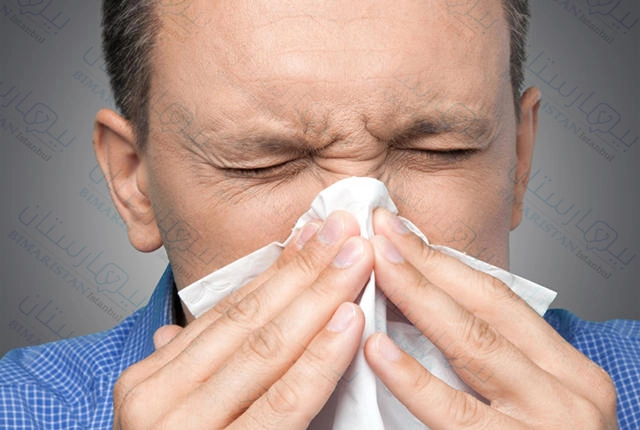
علامات التهاب الجيوب الأنفية
قد يصاب الشخص بالتهاب الجيوب الأنفية إذا عانى من:
- مخاط سميك أصفر أو أخضر.
- الأعراض التي لا تبدو أنها مرتبطة بمواقف معينة.
- ألم في اللثة أو فوق الأسنان.
- رائحة كريهة للفم.
- الإحساس بالضغط الشديد في الوجه.
- انخفاض القدرة على الشم أو التذوق.
- الحمى.
الملخص
يكون إنذار المرض جيد بالنسبة لمعظم حالات التهاب الجيوب الأنفية، غالباً ما تختفي التهابات الجيوب الأنفية من تلقاء نفسها في غضون أسبوع أو أسبوعين.
وعندما لا تختفي الأعراض قد تكون العدوى بكتيرية، ويمكن للمضادات الحيوية في هذه الحالة أن تفي بالغرض.
على الرغم من ندرتها، إلا أن عدوى الجيوب الأنفية الفطرية يمكن أن تكون شديدة ويصعب علاجها.
مع الرعاية الطبية المناسبة، يتعافى معظم المصابين بالتهاب الجيوب الأنفية جيداً، ومع ذلك إذا لم تتحسن العدوى بعد ثلاثة أشهر، فقد يقوم الطبيب بإحالة المريض إلى أخصائي الأذن والأنف والحنجرة الذي يمكنه تحديد السبب الكامن وراء التهاب الجيوب الأنفية المزمن وعلاجه.
